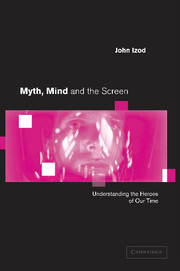Book contents
- Frontmatter
- Contents
- Acknowledgments
- Introduction
- 1 Jungian theory, textual analysis and audience play
- 2 Archetypal images: signification and the psyche
- 3 Archetypal images: symbols and the cultural unconscious
- 4 The Piano, the animus and colonial experience
- 5 The pop star as icon
- 6 The quest of a female hero: The Silence of the Lambs
- 7 Television sport and the sacrificial hero
- 8 The polycentred self: The Passion of Darkly Noon
- 9 Haunted: searching for the whole self
- 10 Transforming the final ghost: the god within
- Conclusion
- Filmography
- Glossary of Jungian and related terms
- References
- Index
6 - The quest of a female hero: The Silence of the Lambs
Published online by Cambridge University Press: 22 September 2009
- Frontmatter
- Contents
- Acknowledgments
- Introduction
- 1 Jungian theory, textual analysis and audience play
- 2 Archetypal images: signification and the psyche
- 3 Archetypal images: symbols and the cultural unconscious
- 4 The Piano, the animus and colonial experience
- 5 The pop star as icon
- 6 The quest of a female hero: The Silence of the Lambs
- 7 Television sport and the sacrificial hero
- 8 The polycentred self: The Passion of Darkly Noon
- 9 Haunted: searching for the whole self
- 10 Transforming the final ghost: the god within
- Conclusion
- Filmography
- Glossary of Jungian and related terms
- References
- Index
Summary
The mythological journey of the hero as recognised by classical Jungians represents a pattern of transformation long since rendered familiar by repetition in numerous guises across many forms of narrative art. (We took a preliminary look at a variant upon the theme in Chapter 2 when we discussed Jules' progress as he first gained access to and then learnt more fully to know the Diva.) The complete journey of a hero entails a process of separation, initiation and return. The hero leaves the daylight world of ego to descend into the dark underworld, which is for Jungians the symbolic realm of the unconscious. There he faces extreme danger or defies a monster, typically suffering an injury in the process. Some would-be victors fail, or allow themselves to be seduced into staying among the shadowy forms beneath ground. But to finally claim his place as a hero he must return to the world, bringing with him the fruits of his conquest. In the locus classicus of this particular topos, the hero returns carrying the grail.
Jung describes the hero's transformation as symbolising his separation from his earlier state of consciousness. To complete the process he has to confront and break the mould of the unconscious dispositions inherited from his parents (and in particular from the mother). He does so with the intuitive goal of emerging renewed from this encounter with his innermost self.
- Type
- Chapter
- Information
- Myth, Mind and the ScreenUnderstanding the Heroes of our Time, pp. 105 - 123Publisher: Cambridge University PressPrint publication year: 2001



